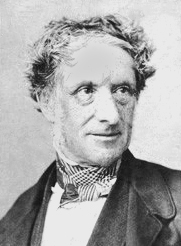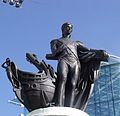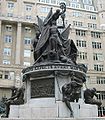Richard Westmacott
Sir Richard Westmacott | |
|---|---|
 | |
| Born | 15 July 1775 London, England |
| Died | 1 September 1856 (aged 81) London |
| Resting place | Chastleton, Oxfordshire |
| Nationality | British |
| Known for | sculpture |
Sir Richard Westmacott RA (15 July 1775 – 1 September 1856) was a British sculptor.[1]
Life and career[]
Westmacott studied with his father, also named Richard Westmacott, at his studio in Mount Street, off Grosvenor Square in London before going to Rome in 1793 to study under Antonio Canova.[2] Westmacott devoted all his energies to the study of classical sculpture, and throughout his life his real sympathies were with pagan rather than with Christian art. Within a year of his arrival in Rome he won the first prize for sculpture offered by the Florentine Academy of Arts, and in the following year he gained the papal gold medal awarded by the Academy of St Luke with his bas-relief of Joseph and his brothers.[3] On returning to England in 1797, he set up a studio, where John Edward Carew and Musgrave Watson gained experience.
Westmacott had his own foundry at Pimlico, in London, where he cast both his own works, and those of other sculptors, including John Flaxman's statue of Sir John Moore for Glasgow. Late in life he was asked by the Office of Works for advice on the casting of the relief panels for Nelson’s Column.[4] He also had an arrangement with the Trustees of the British Museum, which allowed him to make moulds and supply plaster casts of classical sculpture in the museum's collection to country house owners, academies and other institutions.[4]

Westmacott exhibited at the Royal Academy between 1797 and 1839. His name is given in the catalogues as "R. Westmacott, Junr." until 1807, when the "Junr." was dropped.[5] He was elected an associate of the Royal Academy in 1805, and a full academician in 1811.[2] His academy diploma piece, a marble relief of Jupiter and Ganymede, remains in the Academy's collection.[6] He was professor of sculpture at the Academy from 1827 until his death.[2] He received his knighthood on 19 July 1837.[7][8]
Works[]
Among Westmacott's works are the reliefs for the north side of Marble Arch, the sculptures of figures representing The Progress of Civilisation on the pediment of the British Museum,[9] and the Waterloo Vase now in Buckingham Palace Gardens. This enormous urn was sculpted from chunks of marble earmarked by Napoleon for a trophy commemorating his anticipated victory in the Napoleonic Wars and then given to George IV as a gift from the Grand Duke of Tuscany.
His statue of Horatio Nelson, Birmingham was the first statue of Nelson unveiled in Britain. There are other monuments to Nelson by Westmacott at the Bull Ring, Birmingham, in Barbados,[citation needed] while that at Liverpool was modelled and cast by Westmacott, to a design by Matthew Cotes Wyatt.[4][10] In Liverpool there is also an equestrian statue of King George III sculpted by Westmacott, which was unveiled in 1822.[11] He was responsible for the statue of the agriculturalist and developer Francis Russell, 5th Duke of Bedford in Russell Square, and the one of the Duke of York on top of the column in Waterloo place.[2] His Achilles in Hyde Park, a bronze copy of an antique sculpture from Monte Cavallo in Rome, is a tribute to the Duke of Wellington, paid for by £10,000 raised by female subscribers.[12][9]
His sculptures of poetical subjects were in a style similar to those of the contemporary Italian school: his works of this type included Psyche and Cupid for the Duke of Bedford; Euphrosyne for the Duke of Newcastle; A Nymph Unclasping her Zone; The Distressed Mother and The Houseless Traveller.[2]
Westmacott also sculpted the memorials to William Pitt the Younger, Spencer Perceval, Charles James Fox and Joseph Addison in Westminster Abbey; the statue of Fox in Bloomsbury Square; and those to Sir Ralph Abercromby, Lord Collingwood and Generals Pakenham and Gibbs in St Paul's Cathedral.[2]

His other sepulchural monuments include those to Lt. General Christopher Jeaffreson (died 1824) in St.Mary's Church in Dullingham;[13] to Commander Charles Cotton (died 1828) at St. Mary's Church in Madingley;[14] to William Pemberton (died 1828) at St Margaret's Church in Newton, South Cambridgeshire;[15] to Sir George Warren (died 1801) at St. Mary's Church, Stockport in Greater Manchester, depicting a standing female figure by an urn on a pillar;[16] to Rev. Charles Prescott (died 1820), in St. Mary's Church, Stockport, showing a seated effigy[16] and to Mary Henson (died 1805) in Bainton parish church, showing a seated figure against an urn. A bust of David Garrick by Westmacott is in Lichfield Cathedral.[17]
He created a sculptural group for the marble arch of the to Hyde Park.[18]
Personal life[]
Westmacott lived and died at 14 South Audley Street, Mayfair, London where he is commemorated by a blue plaque.[19] Two of his brothers, George, who was active between 1799 and 1827, and Henry, (1784–1861) were also sculptors.[9] In 1798 Westmacott married Dorothy Margaret Wilkinson.[3] Their son, also called Richard Westmacott, followed closely in his footsteps also becoming a notable sculptor, a Royal Academician and professor of sculpture at the academy.
Westmacott is buried in a tomb at St Mary's Church, Chastleton in Oxfordshire, where his third son Horatio was rector in 1878.
Selected works[]
| Image | Title / subject | Location and coordinates |
Date | Type | Material | Dimensions | Designation | Wikidata | Notes |
|---|---|---|---|---|---|---|---|---|---|

|
Adam Duncan, 1st Viscount Duncan | Crypt of St Paul's Cathedral, London | Statue on pedestal | Stone | |||||

|
John Locke | University College London | 1808 | Statue | Marble | ||||
 More images |
Statue of Horatio Nelson | The Bull Ring, Birmingham, West Midlands | 1809 | Sculpture group on pedestal | Bronze and stone | Grade II* | Q7604486 | [17][20] | |
 More images |
Francis Russell, 5th Duke of Bedford | Russell Square, London | 1809 | Statue group on cylindrical pedestal | Bronze and granite | Grade II | Q27082115 | [17][21] | |
 More images |
Statue of Robert Milligan | West India Docks, London | 1813 | Statue on pedestal with plaques | Bronze and stone | Q96183031 | Removed 2020 | ||
 More images |
Monument to Horatio Nelson | Exchange Flags, Liverpool | 1813 | Statue group on pedestal with plaques | Stone, bronze and granite | Grade II* | Q4343277 | Designer, Matthew Cotes Wyatt[17][22] | |
 More images |
Statue of Charles James Fox | Bloomsbury Square, London | 1814, erected 1816 | Statue on cuboid pedestal | Bronze and granite | 5.2m tall | Grade II* | Q17542668 | [17][23][24] |
 More images |
William Pitt the Younger | Pembroke College, Cambridge | 1819 | Statue on pedestal | |||||
 More images |
Wellington Monument, London | Hyde Park Corner, London | 1822 | Statue on pedestal | Bronze and granite | Grade I | Q13528921 | [17][25][9] | |
 More images |
George III | Monument Place, Liverpool | 1822 | Equestrian statue on pedestal | Bronze and stone | Grade II | Q26629818 | [17][26] | |
 More images |
Statue of George III | Windsor Great Park | 1831 | Equestrian statue on pedestal | Bronze and stone | Grade I | Q7727584 | [17][27] | |
 More images |
Statue of George Canning | Parliament Square, London | 1832 | Statue on pedestal | Bronze and granite | 7.9m tall | Grade II | Q21546419 | [17][23][28] |
 More images |
Duke of York | Duke of York Column, London | 1833 | Statue on pedestal and column | Bronze and stone | 4.2m statue, 3m pedestal, 34m column | Grade I | Q2911131 | Architect, Benjamin Dean Wyatt[17][23][29] |

|
Dr. John Alderson | Hull Royal Infirmary | 1833 | Statue on pedestal | Marble and stone | Grade II | Q26568781 | [17][30] | |

|
Dorothy Margaret Westmacott | St Nicholas' Church, Brighton | 1834 | Funerary bust | |||||

|
Mary, Queen of Scots | Hardwick Hall, Derbyshire | Statue on pedestal | Marble and stone | Relocated from Chatsworth House[17] |
References[]
- ^ "Richard Westmacott". Royal Academy of Arts.
- ^ Jump up to: a b c d e f Charles Knight, ed. (1858). "Westmacott, Sir Richard, R.A.". The English Cyclopedia. Biography – Volume 6. London: Bradbury and Evans. p. 653.
- ^ Jump up to: a b Chisholm 1911, p. 547.
- ^ Jump up to: a b c British bronze sculpture founders and plaster figure makers, 1800-1980, National Portrait Gallery
- ^ Algernon Graves (1905). The Royal Academy: A Complete Dictionary of Contributors from its Foundations in 1769 to 1904. 8. London: Henry Graves. pp. 239–40.
- ^ "Jupiter and Ganymede, 1811". Royal Academy. Retrieved 3 July 2012.
- ^ "No. 19525". The London Gazette. 25 July 1837. p. 1910.
- ^ Chisholm 1911, pp. 547–548.
- ^ Jump up to: a b c d Ian Chilvers (2004). The Oxford Dictionary of Art. Oxford University Press. ISBN 0-19-860476-9.
- ^ "Prisoner sculpture from the monument to Lord Nelson". Liverpool Museums. Retrieved 3 July 2012.
- ^ Liverpool Mercury, 27 September 1822
- ^ Henry B. Wheatley (1891), "Hyde Park", London Past and Present: Its History, Associations and Traditions, 2, London: John Murray, p. 253
- ^ Pevsner 1970, p. 332.
- ^ Pevsner 1970, p. 435.
- ^ Pevsner 1970, p. 443.
- ^ Jump up to: a b Nikolaus Pevsner; Edward Hubbard (2003) [1971], The Buildings of England: Cheshire, New Haven: Yale University Press, pp. 339–340, ISBN 0-300-09588-0
- ^ Jump up to: a b c d e f g h i j k l Jo Darke (1991). The Monument Guide to England and Wales. Macdonald Illustrated. ISBN 0 356 17609 6.
- ^ Charles Kendall Adams (ed.). Johnson's Universal Cyclopædia: A New Edition. 8. p. 717. ("Westmacott, Sir Richard M.A." entry revised by Russell Sturgis) (found in this Google book search)
- ^ "English Heritage website". Archived from the original on 25 September 2006. Retrieved 12 March 2007.
- ^ Historic England. "Monument to Lord Nelson (1343362)". National Heritage List for England. Retrieved 22 October 2020.
- ^ Historic England. "Statue of Francis Russell, 5th Duke of Bedford (1246153)". National Heritage List for England. Retrieved 23 October 2020.
- ^ Historic England. "Nelson Monument (1068235)". National Heritage List for England. Retrieved 23 October 2020.
- ^ Jump up to: a b c John Blackwood (1989). London's Immortels. The Complete Outdoor Commemorative Statues. Savoy Press. ISBN 0951429604.
- ^ Historic England. "Statue of Charles James Fox at north end of garden (1244458)". National Heritage List for England. Retrieved 22 October 2020.
- ^ Historic England. "The Achilles Statue (1231393)". National Heritage List for England. Retrieved 22 October 2020.
- ^ Historic England. "George III Monument (1346252)". National Heritage List for England. Retrieved 23 October 2020.
- ^ Historic England. "Statue of George III (1323671)". National Heritage List for England. Retrieved 22 October 2020.
- ^ Historic England. "Statue of George Canning (1226371)". National Heritage List for England. Retrieved 22 October 2020.
- ^ Historic England. "Duke of York Column and Steps (1239383)". National Heritage List for England. Retrieved 23 October 2020.
- ^ Historic England. "Statue of Doctor John Alderson Outside Hull Royal Infirmary (Infirmary Not Included) (1279574)". National Heritage List for England. Retrieved 8 July 2021.
Sources[]
- Busco, Marie. "Westmacott, Sir Richard (1775–1856)". Oxford Dictionary of National Biography (online ed.). Oxford University Press. doi:10.1093/ref:odnb/29114. (Subscription or UK public library membership required.)
- Dodgson, Campbell (1899). . In Lee, Sidney (ed.). Dictionary of National Biography. 60. London: Smith, Elder & Co.
- This article incorporates text from a publication now in the public domain: Chisholm, Hugh, ed. (1911). "Westmacott, Sir Richard". Encyclopædia Britannica. 28 (11th ed.). Cambridge University Press. pp. 547–548.
- Pevsner, Nikolaus (1970). Cambridgeshire. The Buildings of England (second ed.). Penguin Books.
External links[]
| Wikimedia Commons has media related to Richard Westmacott. |
- 24 artworks by or after Richard Westmacott at the Art UK site
 Hindoo Girl, By an Urn, from a Group, by Westmacott. A poem by Letitia Elizabeth Landon in Friendship's Offering, 1826.
Hindoo Girl, By an Urn, from a Group, by Westmacott. A poem by Letitia Elizabeth Landon in Friendship's Offering, 1826.
- 1775 births
- 1856 deaths
- British architectural sculptors
- British male sculptors
- British sculptors
- Monumental masons
- Neoclassical sculptors
- Royal Academicians
- Sculptors from London
- Sibling artists
